Red Cross + You
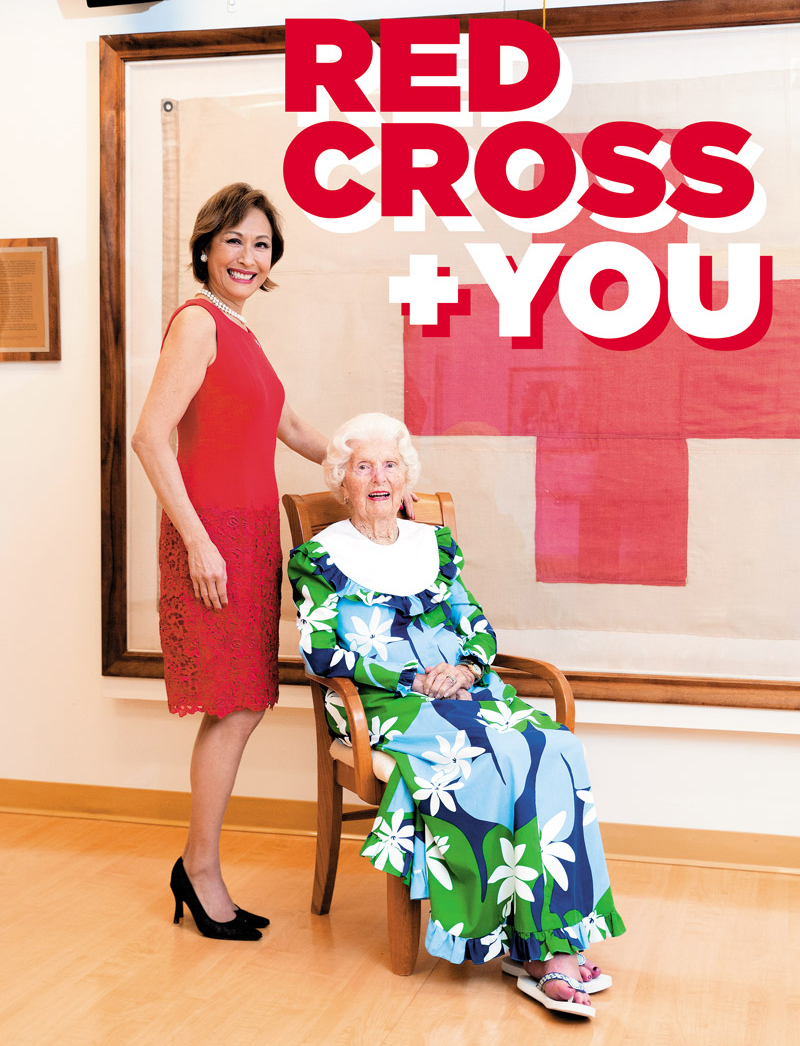
American Red Cross of Hawaii celebrates its centennial this year, and CEO Coralie Chun Matayoshi — and longtime volunteer LaBurta Atherton, who also is ringing in her 100th birthday in 2017 — share how important volunteers are to the organization
American Red Cross of Hawaii has been there for the state and the rest of the world in many capacities during its 100 years as an organization. It has seen remnants of the worst disasters and tragic incidents that leave families, cities and countries in shambles, and has stepped up each time it was called to offer relief and kindness.
But for its centennial this year, it is not asking for accolades or rounds of applause for all its done. Its birthday wish is something much more simple.
“What we want for people to do to celebrate is to go onto our website and take advantage of all the tools to prepare themselves, their families and organizations for a disaster,” says CEO Coralie Chun Matayoshi. “We want people to volunteer, we need financial support, and we want people to be prepared. If Hawaii people don’t help us, we don’t have a strong Red Cross.”
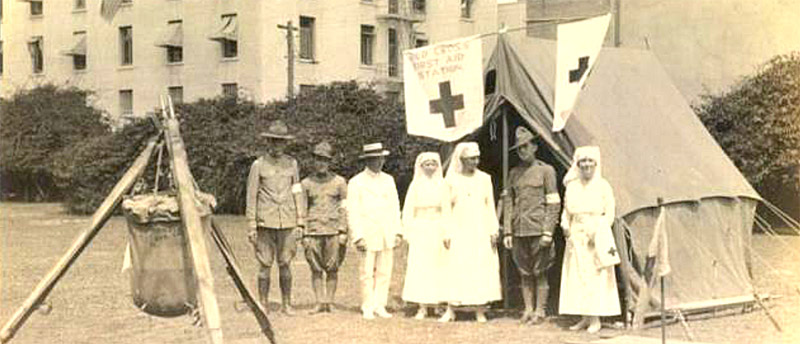
An American Red Cross of Hawaii first-aid station in 1917
PHOTO FROM AMERICAN RED CROSS OF HAWAII
Mandated by Congress to respond to every disaster (manmade and natural) within U.S. borders, Red Cross chapters do that every eight minutes — and every four days in Hawaii.
It’s a hefty responsibility to take on, and the position requires a special heart to lead it.
“I just fell in love with the mission,” says Matayoshi, who has been involved with volunteerism in various capacities all her life. “Red Cross allows me to live my passion and make a difference.”
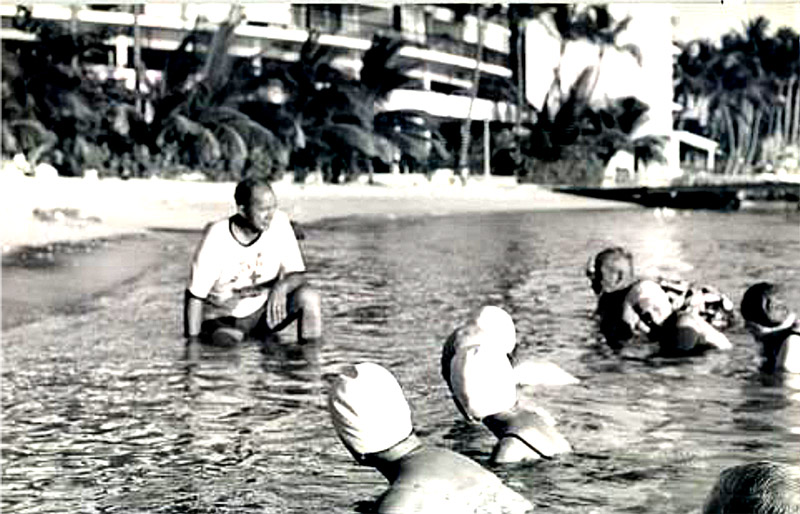
An American Red Cross of Hawaii volunteer leads a swimming lesson at Waikiki Beach in the 1950s
PHOTO FROM AMERICAN RED CROSS OF HAWAII
American Red Cross of Hawaii is on call 24/7, 365 days a year, and it is the first organization first responders contact when disaster strikes.
“If there’s a fire or a police standoff, chemical spill or aircraft accident, we’re the ones that get called,” says Matayoshi.
Natural disasters constantly are on the radar, as well. Within the first two months of the past hurricane season, American Red Cross of Hawaii opened 48 shelters and housed 728 people.
“People thought we dodged a bullet,” she continues. “But we were out there every single week, every single time.”
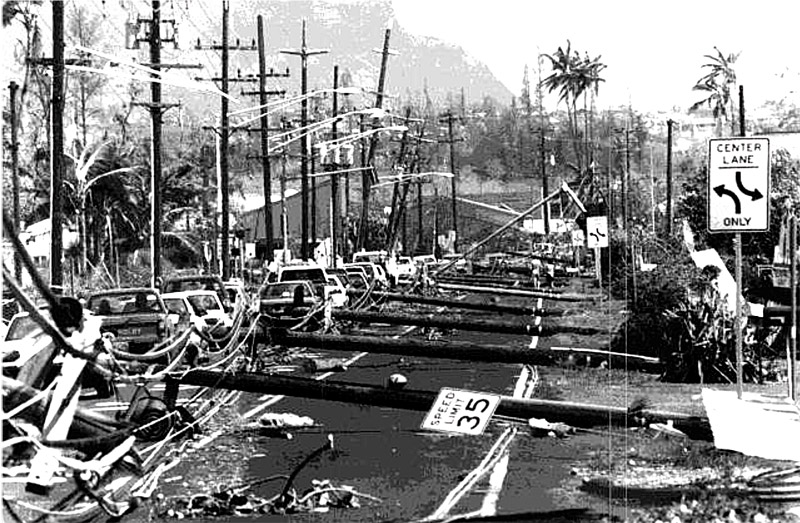
When Hurricane Iniki hit Kauai in 1992, American Red Cross of Hawaii was there to help
PHOTO FROM AMERICAN RED CROSS OF HAWAII
Hurricane and tsunami scares have come and gone with nothing really coming to fruition, but, says Matayoshi, that is not the point. The reasoning, she adds, is that being prepared has to be done before disaster strikes. Water supplies must be ready and available, shelters must be erected, supplies must be pre-positioned and plans must be in place.
Red Cross’ original mission of disaster response now shares the spotlight with disaster preparedness. The shift spurred changes within the organization over the past 15 years after 9/11.
“The storms are more severe, there are more threats of terrorist attacks, a lot of people are traveling more,” she explains. “There’s just a lot going on, and we need to worry about so many more things than before when it was just natural disasters.
“You have to be ahead of the game, especially in Hawaii.”
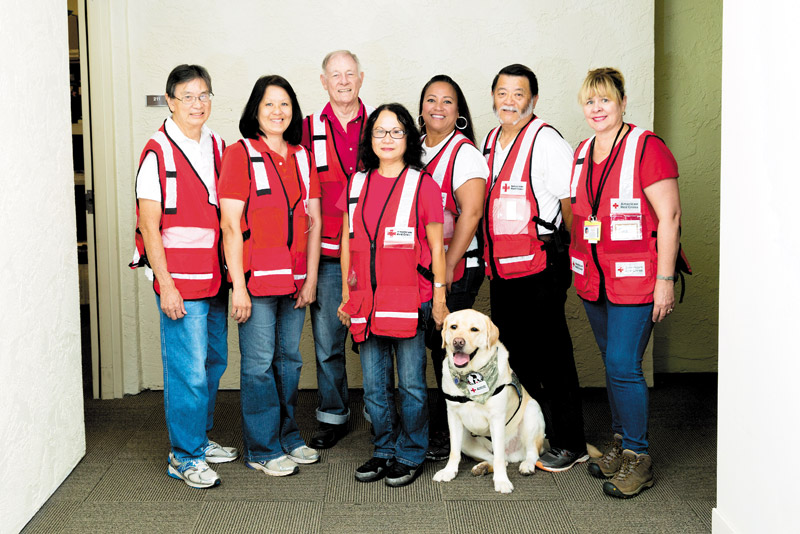
Current American Red Cross of Hawaii volunteers (from left) Wes and Shari Ching, Ray Moody, Millie Griggs and service dog Ollie, Renise Bayne, Ken Aoki and Tina Doty
A big part of the changes include more of a focus on community education. Programs are in place for emergency training, like AED usage and CPR protocol, and now many of the lessons can be done online. Red Cross put together a Home Fire Preparedness Campaign to install smoke alarms, educate the community on how to prevent house fires and how to escape from a fire.
There also has been a big push for keiki education as evidenced in The Pillowcase Project, which helps children learn the best way to stay safe during an emergency, manage stress and ultimately escape from a disaster without harm.
The number of community education programs are many, which means American Red Cross of Hawaii has a lot on its plate, as does Matayoshi, who continues to be challenged, and welcomes the prospect of helping mold the organization to better help Hawaii and the rest of the world.
“Because we’re all one organization, we all help each other,” she says of the national Red Cross. “Each one of us is going to be a victim at some point, and Hawaii, we’re right in the middle of the Pacific, we’re an isolated population and we really need the help (when disaster hits).”
With all the changes American Red Cross of Hawaii has gone through, one thing that has remained the same is its reliance on dedicated volunteers.
And it touts some big names in the likes of Princess Ka‘iulani, Queen Lili‘uokalani, Duke Kahanamoku and late U.S. Sen. Daniel Inouye. The latter joined the organization as a volunteer, while still a teenager, and at the age of 17 was called to action when the Japanese bombed Pearl Harbor on Dec. 7, 1941.
As he was getting ready for church, Inouye heard the news over the radio waves. He stepped outside to see billowing smoke and plane formations overhead.
“He got the call from Red Cross because he’s a volunteer trained in first aid,” explains Matayoshi. “So he grabs two pieces of bread, pedals one mile to Lunalilo Elementary School, where there’s a first-aid station, and doesn’t come back for five days.”
Kahanamoku, meanwhile, made his mark with American Red Cross of Hawaii when the 1916 Summer Olympics, slated to take place in Berlin, Germany, was canceled. Since he could not compete, he helped rally other American Olympic swimmers to conduct aquatic exhibits around the nation to raise money for Red Cross. He also taught swimming and knitted sweaters for WWI soldiers.
Even further back in American Red Cross of Hawaii’s history are Queen Lili‘uokalani, who sewed a literal red cross flag during WWI and helped roll bandages in the throne room, and Princess Ka‘iulani, who cared for soldiers traveling from the Philippines during the Spanish-American War. Ka‘iulani and 300 other from the late 1890s are, as some say, the actual beginnings of American Red Cross in Hawaii — although the chapter officially was chartered in 1917.
“We really have a neat history of people that came to help,” Matayoshi says. “But also everyday people. It’s just the human nature to want to help.”
Today, that sentiment echoes around the state. It’s seen in the disaster action teams (DATs) that deploy anywhere in the world within the span of two hours. It’s clear in the work done by clinical professionals, like nurses and counselors, who offer assistance in critical situations. It’s evident in the volunteers who attend community education events at businesses and schools. It’s apparent in those who dedicate their time to office work and coordinating fundraising efforts.
A notable volunteer is LeBurta Atherton, who celebrates her own centennial in May. Once a gray lady during WWII, Atherton recalls her time lifting the spirits of military servicemen and civilians who were injured and in the hospital.
“They did things like plan holiday parties and arts-and-crafts, and they helped them write letters to home,” explains Matayoshi.
Atherton has been affiliated with Red Cross for most of her life, and even inspired eldest daughter Balbi Brooks to join the cause. Brooks has been an active volunteer on Hawaii island for some time now, and even has deployed on national operations. Atherton, meanwhile, remains a dedicated volunteer, and now serves in a philanthropic capacity.
“She helps us enable others,” says Matayoshi. “She encourages others to help, and also helps finance our operations so they can help.”
“It’s easy to volunteer,” continues Matayoshi, adding that 97 percent of American Red Cross of Hawaii is made up volunteers. “People all want to help, but they don’t really know how sometimes. We have the infrastructure, the organization, the equipment, the training to be able to allow people to do that.”
Aside from disaster relief and everyday catastrophes such as flooding and house fires, American Red Cross of Hawaii also is responsible for offering services to the armed forces. American Red Cross of Hawaii also is expanding its military support to veterans and non-deployed members.
“We do so much for the military,” Matayoshi says proudly. “When a soldier from Hawaii is in Iraq, and his father passes away, we’ll get word to their command so that soldier can come home and say his last goodbye. We’ll help them with mental health and social workers. We’re going to help with funeral arrangements and everything by connecting them with other organizations.”
More than 20 canines are employed by American Red Cross of Hawaii, and their main job is to help returning soldiers cope with multiple deployments or the effects of PTSD. It’s all part of the Red Cross healing, which reaches out to all who are hurting.
Organization volunteers also help victims deal with the aftermath of disasters. On staff are a number of nurses, clinical psychologists, mental health specialists and counselors, who stay long after the tragedy has come and gone.
The list of duties the organization assumes is extensive, and the help it gives spreads from preparedness and disaster relief (both at home and around the world) to keiki and community education and counseling. It’s difficult to think of an institution that is more well-equipped.
Its responsibilities and capabilities beg the question: What can’t American Red Cross of Hawaii do?
American Red Cross of Hawaii has done a lot for the state and the world in its 100 years as an organization, and to continue the good work it needs the public’s help. It needs financial assistance, it needs volunteers, it needs more willing hearts that have a desire to help others.
“Our community needs to help us, otherwise we can’t help the people of Hawaii,” Matayoshi concludes.
American Red Cross of Hawaii is located at 4155 Diamond Head Road. Call 734-2101 or visit hawaiiredcross.org for more information.
10 Things You Might Not Know About American Red Cross of Hawaii
1) Its mission is to prevent and alleviate human suffering in the face of emergencies by mobilizing the power of volunteers and the generosity of donors.
2) It is not a government agency; it is chartered by Congress.
3) It responds to disasters in Hawaii every four days.
4) It is ready to respond to disasters 24/7, thanks to its volunteer base.
5) It is an expert organization when it comes to mental health counseling.
6) It provides emergency communication between deployed military service members and their loved ones, and conducts international tracing services for families torn apart by war or disaster.
7) Its entire volunteer program is run out of Tripler Army Medical Center.
8) It teaches 20,000 people each year how to save lives.
9) It conducts free swimming classes every summer and staffs first-aid stations at events.
10) It needs the public’s help.






